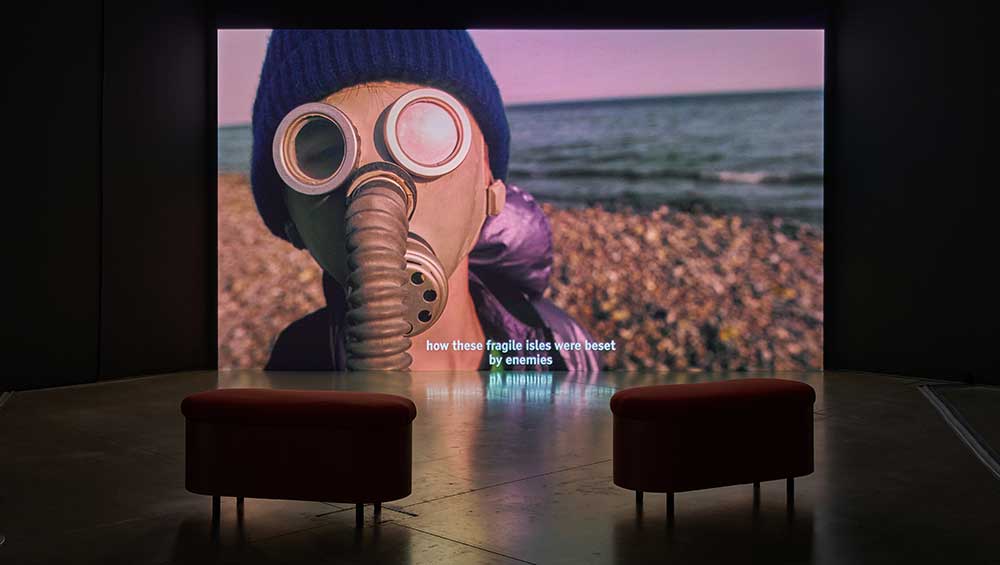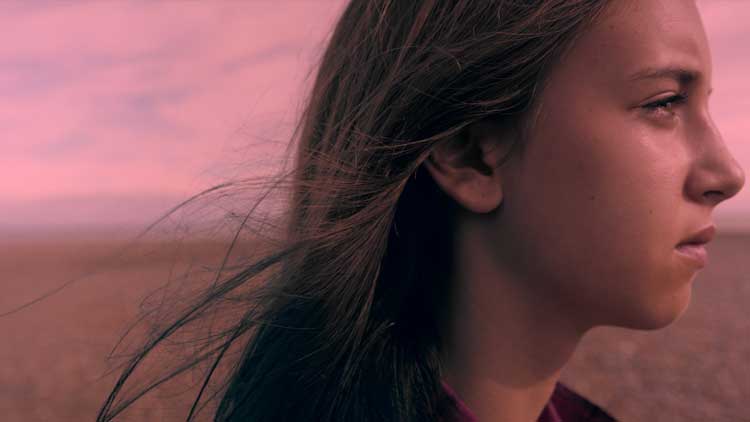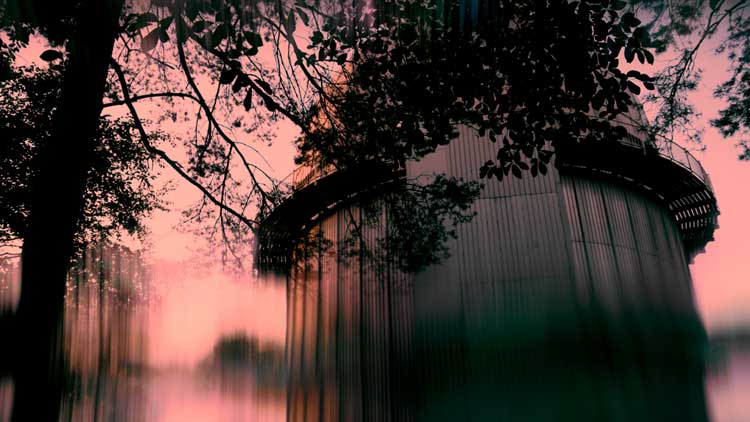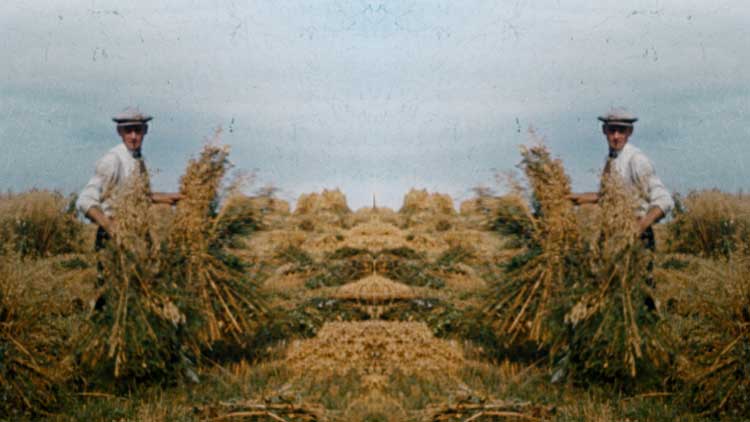
David Blandy: Atomic Light, installation view, John Hansard Gallery, Southampton.
John Hansard Gallery, Southampton
11 February – 6 May 2023
by DAVID TRIGG
“There is a familial myth that my late grandfather would not have survived being a Japanese prisoner of war had the atomic bombing of Hiroshima not occurred,” says David Blandy. “So, it could be argued that I owe my existence to one of the most terrifying events of human history.” The artist’s maternal grandfather, David Piper, was one of more than 190,000 British and Commonwealth troops captured by Japan in the second world war. His liberation came in 1945, after the devastating nuclear attacks on Hiroshima and Nagasaki brought the conflict to a swift conclusion. This problematic slice of family lore haunts Blandy’s four interconnected films in Atomic Light at the John Hansard Gallery, which interweaves the present with the past and the future to expand his explorations of history, empire and environmental collapse.

David Blandy, The Edge of Forever, 2022, film still. © the Artist.
Blandy first addressed his relationship with the A-bomb in the film Child of the Atom (2010), in which scenes showing the artist and his young daughter visiting Hiroshima are juxtaposed with apocalyptic anime. Ostensibly born from a desire to confront feelings of vicarious guilt, the film raises tantalising questions about how we might negotiate the role that historical events and injustices have had in shaping our present way of life. These ideas are integral to the video The Edge of Forever (2022), which opens the exhibition with a mix of science fiction, animation and beautiful cinematography to tell the semi-autobiographical story of two children coming to terms with the inextricable links between their familial history, war and environmental breakdown.

David Blandy, The Edge of Forever, 2022, film still. © the Artist.
The film takes us from the majestic chalk cliffs at Cuckmere Haven in East Sussex (where Blandy’s grandfather lived) inland, to an eerie abandoned observatory in Herstmonceux. “There were myths that we won the war, that all the hardships, the sacrifices were worth it,” says the teenage narrator (Blandy’s daughter) as the children traipse through sun-dappled woodland. “But, instead, we’d succumbed to the slow poison. The poison of limitless growth.” The children are seen wearing gas masks as a post-apocalyptic world is described, a planetarium is visited, and an animated sequence narrated by Blandy outlines his grandfather’s story: “Then the world changed. The atomic age began. And the soldier was saved, by an act of genocide.” Despite its formal beauty and poetic stylings, The Edge of Forever oozes with anxiety about our world’s future. It leaves you hanging, in a pessimistic state, with little sense of hope.

David Blandy, Soil, Sinew and Bone, 2022, film still. © the Artist. Images courtesy of Screen Archive South East.
Taking a different approach, Soil, Sinew and Bone (2022) is a film essay that poetically traces the links between agriculture and warfare, charting the west’s shift from the age of horse-power to our overly industrialised era and attendant environmental consequences. The collage of archive footage includes scenes of British farming in the 1930s, wartime Anderson shelters being installed, schoolchildren wearing gas masks, a shrine on Miyajima island in Hiroshima Bay not long before the bomb was dropped, and a Florida-based phosphate factory – nitrates, we are reminded, are used to fertilise soil as well as create violent weapons of war. The doubled and mirrored images are accompanied by Blandy’s dulcet narration, inviting us to consider the lives of those on screen and how the ripples of history continue to affect us. We are again left wondering if another world is possible. “Is there peace in knowing that the flowers will bloom again?,” the artist cynically asks.
.jpg)
David Blandy, Sunspot, 2023, film still. © the Artist. With permission from The Huntington Library, California, USA.
Archival footage is also used in Sunspot (2023), the shortest and least coherent work in the show, which feels at home in this context, but otherwise seems less convincing. Projected inside a structure shaped like an observatory, the short film tells of two sunspot observers: Joseph Hickox at the Mount Wilson Observatory in LA and Yukiaki Tanaka at the Tokyo Astronomical Observatory. Both made drawings of the sun on 6 August 1945 – the day a deadly atomic sun was made on Earth, killing more than 100,000 people. The documentary footage is accompanied by a female voiceover musing on the vastness of time and space and tracing somewhat tenuous connections between the solar scientists, the atomic bomb and the climate crisis – the latter represented by scenes of the huge Bobcat wildfire that threatened the Mount Wilson Observatory in 2020.
_3-1-19.jpg)
David Blandy, Empire of the Swamp, 2023, film still. © the Artist.
The most intriguing of Blandy’s new films is Empire of the Swamp (2023), set in Singapore where the artist’s grandfather was held captive. A man is seen wandering from the mangrove swamps on the outskirts of the metropolis to the abandoned Bukit Brown cemetery, estimated to house 100,000 tombs but which is being slowly swallowed up by new developments as the city expands. The script, written by the Singaporean playwright Joel Tan, involves a surreal conversation between a crocodile and the soul of an English soldier lost in the swamps. Coming across like the delirious hallucination of a dehydrated prisoner, the beautifully produced film is a sophisticated modern-day fable of the troubled relationship between man and nature and the repercussions of a colonial past.
_3-1-4.jpg)
David Blandy, Empire of the Swamp, 2023, film still. © the Artist.
With growing anxiety in the west over Russian threats to deploy nuclear weapons in the Ukraine war, and the hands of the Doomsday Clock (designed to predict how close humanity is to apocalyptic annihilation) moving alarmingly close to midnight, Atomic Light conveys a significant sense of urgency as well as despair. Where, then, is hope found? Following the horrific bombing of Hiroshima, few believed that anything would grow again in its decimated soil. But in spring 1946, to the surprise of many, the barren landscape was dotted with the red petals of the oleander, which became a symbol of hope and is now the city’s official flower.
We all know that our actions have consequences, but what the long-term consequences might be and how long their effects will be felt is something we shall never see. Hiroshima today is a lively, bustling city; we see its life in Child of the Atom, screened outside the main exhibition space. Its existence is a testament to nature’s healing power and the human ability to endure, rebuild and find hope in the ruins of destroyed lives. And though the city doesn’t let you forget its nightmarish past, it refutes the fears that it would become an irreparable wasteland. As a symbol of rebirth, the Hiroshima we see in Blandy’s film introduces the possibility of hope for a different, less apocalyptic future, one that is otherwise missing from this provocative and stimulating exhibition.